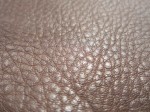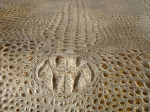
The main purpose of this blog is to become a resource for interior designers, upholsterers and people looking to buy leather. With most of the materials used by designers or upholsterers there are universal terms or specifications that provide you a fairly good idea as to the way the material will perform. If someone tells you a material has 100,000 double rubs it is easy to start to make some conclusions about that material. ASTM or other specification that are standards in fabrics and vinyl are applied to leather in the same way. There are terms that are meant to describe the different characteristics of leather, but there isn’t a body that enforces that they are used properly.
There are many common terms used to describe leather that in North America, in particular, that no longer describe what they were intend to refer to. Some misused or misrepresented terms would be things such as “top grain” and “full grain” or the difference between aniline/semi-aniline/pigmented dyes or even the the marketing of bi-cast leather as real leather. All of these terms are clearly defined in Europe by tannery associations, but for some reason in North America they have been altered.
We encourage people to post questions and stories about experiences they have had with leather.



